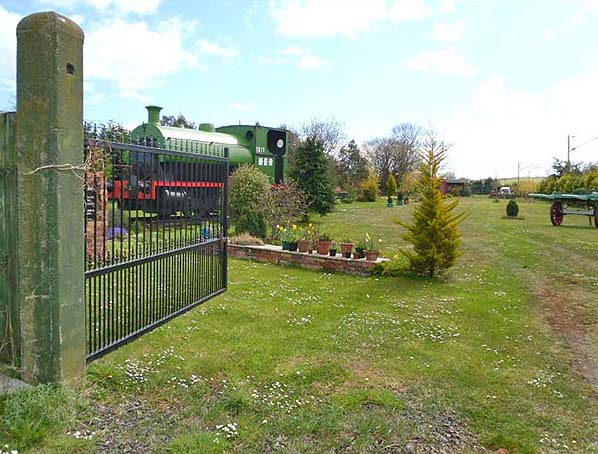
Station Name: BEAL for HOLY ISLAND2.jpg)
Looking south from the level crossing at Beal c1971. Both the station building and the gents’ toilet beyond it are standing but the down platform has been largely demolished. The signal box remains in operation, and would be in use until 1982. The poster board attached to the signal box ironically carries a poster advertising visits to Edinburgh by train – would be passengers would have to make their way to Chathill or Berwick to do this since trains ceased to call at Beal in 1968. The signal box nameboard has been repainted in BR ‘Corporate Identity’ black and white.
Photo by John Mann 4.jpg) Beal station, looking north-west from an up train on 7 September 1972. The platform was cut back in March 1970. In the foreground is the gents’ toilet, built in brick whilst the other buildings were of stone. The station building, which dates from the opening of the station in 1847, is beyond, with the 1870s signal box on the extreme right.
Photo by Alan Young 15.jpg)
Beal station, looking west from the site of the demolished up platform c1972. The down platform has been largely demolished. The station building remains in good order, the pillars of the verandah still resplendent in BR(NE) ‘Oriental Blue’ paint. The structure of the building, consisting of two houses of two storeys, linked by a single-storey waiting section, can clearly be seen from this angle. The signal box is seen beyond the station building, adjacent to the crossing.
Photo
by John Addyman
1.jpg)
Beal station building in March 1975.
Photo from Stafford Linley collection / SINE Project 7.jpg) Beal station building seen in June 1978, looking south from the level crossing. Only the boarded upper-storey window gives any hint that the building’s days are numbered. One of the platform lanterns is placed behind the rear wall of the former platform.
Photo by Keith Holt from the KDH Archive 8.jpg)
The north-western elevation of Beal station. This section was the stationmaster's accommodation, and the porter was provided with a house in the south-eastern block of the station, in essence a separate building linked by a single-storey waiting block to the house on this photograph. The typical N&B architectural features are in evidence: sandstone construction under a tall. pitched roof of Welsh slate; prominent gables of differing sizes, with kneelers at either side; raised gables (raking parapets) which would originally all have carried ball finials on their summits; and mullioned windows. The timber porch with its frilly bargeboard is most attractive, but to its left the later lean-to with brick dado looks singularly out of place. An NER oil lantern is on display. This is how the building looked in June 1978, It would be demolished in 1979.
Photo
by Keith Holt from the KDH Archive
9.jpg)
Beal station is seen in 1979 when demolition was underway. This view from the north-east shows clearly how the station building was formed of a pair of two-storey houses connected by a single-storey waiting area, fronted by a verandah.
Photo by James Cameron 6.jpg)
The only remaining building at Beal station in March 1980 was the signal box, adjoining the level crossing. Even this structure was to be demolished, with the red-brick addition behind it retained as a relay room. Beyond the signal box the gable end of the railway cottages can be seen.
Photo by Alan Lewis from his Ipernity photo gallery 5.jpg)
The site of Beal station looking south from the level crossing in June 2011. Part of the back wall of the former down platform is visible.
Photo by Alan Young  The former goods yard of Beal station, looking south-east in 2013. A Peckett 0-4-0 saddle tank engine (with NER stencilled on) is on display. In December 2011 a planning application was made to use the site for five railway carriages which could be used as holiday lets or bed and breakfast accommodation, only a short drive from Holy Island. Having been granted in May 2012 the site was put on the market for £95,000 in 2013 but has subsequently been withdrawn.
Photo from sale brochure 14.jpg) Looking east in July 2015 towards the former forecourt of Beal station. The brick structure was an extension to the signal box (which formerly stood to its left) and it now serves as a relay room; a ‘Corporate Identity’ nameplate has been provided. The barriers replaced the traditional crossing gates in 1980 and the signal box closed in 1982. The CCTV cameras are monitored from Tweedmouth.
Photo by Terry Callaghan Click on thumbnail to enlarge
|
old_thumb11.jpg)
old_thumb2.jpg)
old_thumb5.jpg)
thumb10.jpg)



thumb11.jpg)
thumb12.jpg)

 Home Page
Home Page